nfitz
Superstar
I don't believe that draft MOU was ever agreed to by both parties and was not signed. Normally the references are to the 2012 MOU which I don't believe references a 2011 version.The MOU (released March 31, 2011) said ...
A bigger question is there a new 2018 MOU signed before the election is called. It's unclear to me what that agreement is.
LOL, I don't think that when one is by one's own admission too stoned and inebriated to function, that the appropriate term is "stabbed in the back"!Once Ford was stabbed in the back, it no longer became about transit and he was trying to play catch-up in the political games that were started by the others.
Particularly with the chief architects being either long-term Progressive Conservatives or Ford appointees!
Besides it saved us from the mistake of trying to grade-seperate between Don Mills and Kennedy, preserving the genius and cost-effectiveness of the Transit City vision for this rapid transit line!





